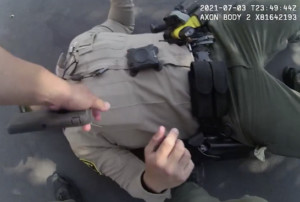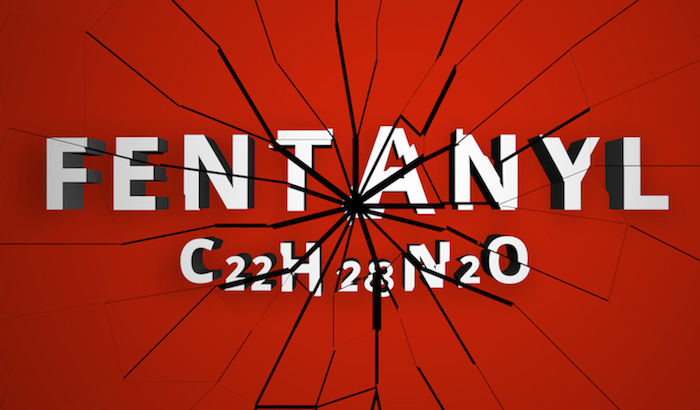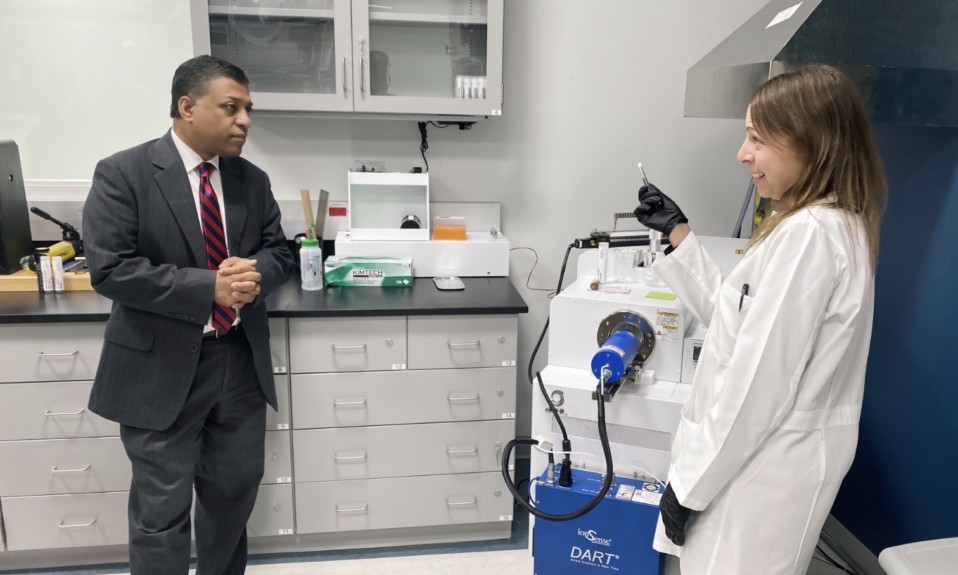The question couldn’t be more important, because we won’t beat back the opioid epidemic without understanding the full scope of this extraordinarily lethal drug
By Jason Langendorf
In an age when a glut of misinformation has overlapped with a global opioid crisis, the drug awareness video released last week by the San Diego County Sheriff’s Department (SDSD) seemed strangely fitting.
In the nearly four-minute video combining officer bodycam footage, interviews and PSA-style warnings, an SDSD deputy is shown conducting a vehicle search that puts him in contact with a white powder identified to be fentanyl. The deputy, dazed and wobbly, falls stiffly to the pavement. After a field training officer administers the overdose-reversal drug naloxone, the deputy is rushed to a hospital and, presumably, makes a full recovery.
“I’m Deputy David Faiivae,” he intones in the video’s follow-up interview, “and I almost died of a fentanyl overdose.”

Except that experts almost universally believe that Faiivae did not overdose. Fentanyl is an indisputably dangerous drug that has given teeth to the growing opioid epidemic, but it’s important for the public to understand both what it is and what it is not. To that end, fentanyl is not a cutaneous poison in the mold of anthrax or sarin—potentially lethal to the touch.
“The only way to overdose is from injecting, snorting or some other way of ingesting it,” Ryan Marino, M.D., medical director of toxicology and addiction medicine at University Hospitals in Cleveland recently told The New York Times. “You cannot overdose from secondhand contact.”
In the midst of the opioid epidemic—and some of the misinformation that has accompanied it—we at TreatmentMagazine.com want to use this space to turn a spotlight on fentanyl, separating fact from myth, laying out several key issues and considering how the effects of this lethal drug can be reined in.
What Is Fentanyl?
First developed by Belgian chemist Paul Janssen in 1959, fentanyl is a synthetic opioid that has the same chemical structure as drugs made from the opium poppy plant. Similar to morphine, but up to 100 times more potent, fentanyl came into use as a pain reliever and anesthetic in medical settings in the 1960s.
Administered to cancer and post-operative patients for whom other medications weren’t strong enough, and favored for delivering more immediate pain relief than morphine without the side effect of nausea, fentanyl became increasingly relied upon in clinical settings. The development in the 1990s of a transdermal fentanyl patch (which hinges on an entirely different physical interaction from Deputy Faiivae’s theoretical contact encounter) increased the drug’s viability.
In its prescription form, fentanyl is known by a number of names, including:
- Actiq
- Duragesic
- Ionsys
- Sublimaze
- Subsys
The risks surrounding fentanyl, including accidental contact with transdermal patches among children, are enormous. But so are the drug’s benefits for pain patients, especially those in end-of-life palliative care.
I think most sensible people agree that there is a basis for opioids to exist. Certainly out in the street, fentanyl is the boogeyman that scares the daylights out of all of us. And yet pharmaceutical fentanyl is used every day, safely, by anesthesiologists. It isn’t evil in and of itself.”
—Brad Schimel, former attorney general of Wisconsin
Fueling the Opioid Epidemic
Because fentanyl is inexpensive to manufacture and exceptionally potent, rogue chemists about a decade ago began producing it in bulk, often using the dark web for sales and distribution. Soon, overdose rates across the U.S. began to spike. The Centers for Disease Control and Prevention (CDC) reported that the number of fentanyl encounters in the U.S. more than doubled from 2014 to 2015, from 5,343 to 13,882. According to congressional testimony from a U.S. Customs and Border Protection official from 2019, the agency seized more than 2,100 pounds of the drug in 2018, compared with only two pounds in 2013.
“As of May 2019, fentanyl was mainly smuggled to the U.S. from China and Mexico,” says Lawrence Weinstein, M.D., chief medical officer at American Addiction Centers. “By May 2019, China said, ‘No, we’re gonna clamp all that.’ But [by then a] network of very clever marketers in China was using online services to sell precursors of fentanyl, and from those precursors, it’s very easy to synthesize it. India has also become an increasingly big [exporter] of illegal fentanyl, so now that is entering the picture.”

In recent years, illegal drug manufacturers have begun cutting other substances (such as heroin and cocaine) with fentanyl, and in some cases unintentionally tainting batches of other drugs with residue left over from fentanyl production. Because of fentanyl’s potency, the result has been an illicit drug supply that has turned the use of everything from opioids to ecstasy, also known as MDMA and Molly, into a game of Russian roulette. Synthetic opioids (including fentanyl), according to the National Institutes of Health, are now the most common drugs involved in overdose deaths in the United States.
As Jason Schwartz, director of behavioral medicine at St. Mary Mercy Hospital in Livonia, Mich., and creator of the addiction-oriented blog Recovery Review, says, “For people who are in earlier stages of opioid use disorders and maybe are less experienced, it’s probably true that they’re unknowingly using fentanyl. Everyone is at greater risk when they’re using fentanyl, but [the less experienced users are] probably at an especially heightened risk. It’s just the potency and the inconsistency of the mix from dose to dose. The range of potency is much greater today than it was years ago due to fentanyl.”
No Easy Answers
Approximately 50 million Americans suffer from chronic pain. For some, fentanyl provides the only true relief they’ll find. Such is one of the problems in addressing the fentanyl tragedy.
“I think most sensible people agree that there is a basis for opioids to exist,” says Brad Schimel, former attorney general of Wisconsin. “Certainly out in the street, fentanyl is the boogeyman that scares the daylights out of all of us. And yet pharmaceutical fentanyl is used every day, safely, by anesthesiologists. It isn’t evil in and of itself.”
And because fentanyl can be easily and cheaply created in a lab setting—and small components of it can be altered to sidestep legal crackdowns in other countries—the drug is here to stay, whether we want it or not. Criminalization of users and supply-side eradication haven’t and won’t work. That leaves a path forward that, while certain to draw criticism from some policymakers and corners of the general population, is a clear one: strong government regulation and harm reduction practices.
Every household in America needs to know that word, fentanyl, and what it is and what can happen. And kids need to be scared.”
—April Babcock to the “Baltimore Sun”
Ethan Nadelmann, founder and former executive director of the Drug Policy Alliance, offers this recommendation: Every opioid prescription should come accompanied by a dose of naloxone. He says the government hasn’t yet done enough to promote the value of what he calls “the miracle antidote for an opioid overdose” and of other harm education measures, such as informing the public of the grave danger of mixing opioids with other substances. Public relations and liability concerns too often restrict education and messaging that might be viewed as condoning drug use, and so, Nadelmann says, “there’s this incredible ignorance about this sort of stuff.”
No one, however, can dispute this: Fentanyl has torn lives and families apart far and wide. Take it from April Babcock, who lost her son to a fentanyl overdose in 2019. Earlier this year, she told the Baltimore Sun: “Every household in America needs to know that word, fentanyl, and what it is and what can happen. And kids need to be scared. You are playing Russian roulette any time you take a pill or do any drug these days.”
Unfortunately, while treatment professionals, law enforcement and policymakers continue to search for answers, the list of people who have suffered the same pain and loss as Babcock grows exponentially.
Image: Shutterstock; photo: Kaur Kristjan













